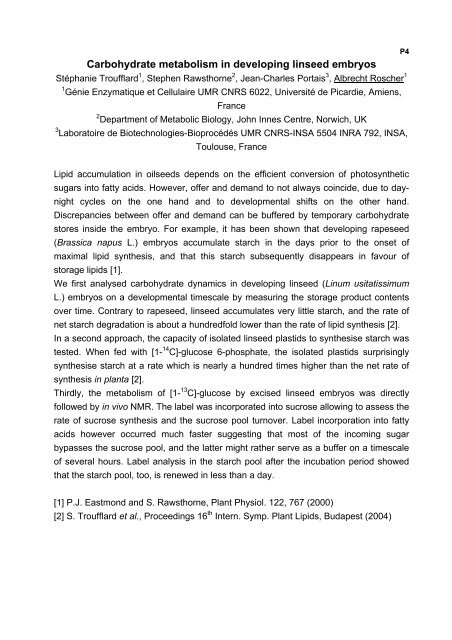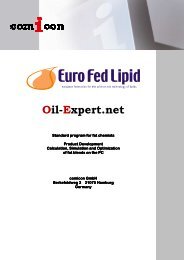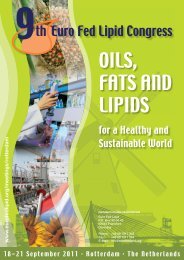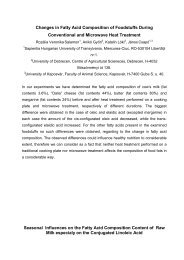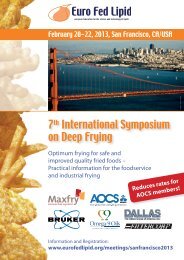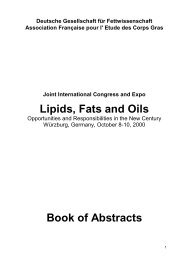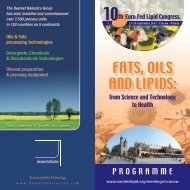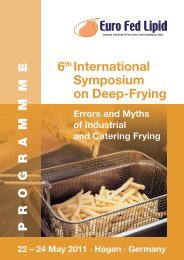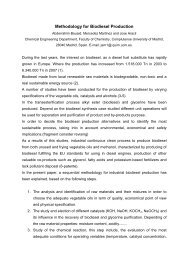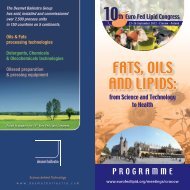Abstracts now available online - Euro Fed Lipid
Abstracts now available online - Euro Fed Lipid
Abstracts now available online - Euro Fed Lipid
Create successful ePaper yourself
Turn your PDF publications into a flip-book with our unique Google optimized e-Paper software.
P4<br />
Carbohydrate metabolism in developing linseed embryos<br />
Stéphanie Troufflard 1 , Stephen Rawsthorne 2 , Jean-Charles Portais 3 , Albrecht Roscher 1<br />
1<br />
Génie Enzymatique et Cellulaire UMR CNRS 6022, Université de Picardie, Amiens,<br />
France<br />
2<br />
Department of Metabolic Biology, John Innes Centre, Norwich, UK<br />
3 Laboratoire de Biotechnologies-Bioprocédés UMR CNRS-INSA 5504 INRA 792, INSA,<br />
Toulouse, France<br />
<strong>Lipid</strong> accumulation in oilseeds depends on the efficient conversion of photosynthetic<br />
sugars into fatty acids. However, offer and demand to not always coincide, due to daynight<br />
cycles on the one hand and to developmental shifts on the other hand.<br />
Discrepancies between offer and demand can be buffered by temporary carbohydrate<br />
stores inside the embryo. For example, it has been shown that developing rapeseed<br />
(Brassica napus L.) embryos accumulate starch in the days prior to the onset of<br />
maximal lipid synthesis, and that this starch subsequently disappears in favour of<br />
storage lipids [1].<br />
We first analysed carbohydrate dynamics in developing linseed (Linum usitatissimum<br />
L.) embryos on a developmental timescale by measuring the storage product contents<br />
over time. Contrary to rapeseed, linseed accumulates very little starch, and the rate of<br />
net starch degradation is about a hundredfold lower than the rate of lipid synthesis [2].<br />
In a second approach, the capacity of isolated linseed plastids to synthesise starch was<br />
tested. When fed with [1- 14 C]-glucose 6-phosphate, the isolated plastids surprisingly<br />
synthesise starch at a rate which is nearly a hundred times higher than the net rate of<br />
synthesis in planta [2].<br />
Thirdly, the metabolism of [1- 13 C]-glucose by excised linseed embryos was directly<br />
followed by in vivo NMR. The label was incorporated into sucrose allowing to assess the<br />
rate of sucrose synthesis and the sucrose pool turnover. Label incorporation into fatty<br />
acids however occurred much faster suggesting that most of the incoming sugar<br />
bypasses the sucrose pool, and the latter might rather serve as a buffer on a timescale<br />
of several hours. Label analysis in the starch pool after the incubation period showed<br />
that the starch pool, too, is renewed in less than a day.<br />
[1] P.J. Eastmond and S. Rawsthorne, Plant Physiol. 122, 767 (2000)<br />
[2] S. Troufflard et al., Proceedings 16 th Intern. Symp. Plant <strong>Lipid</strong>s, Budapest (2004)


